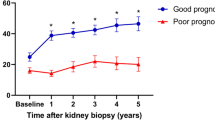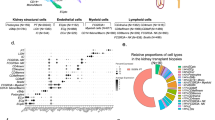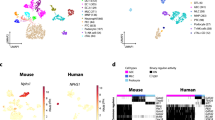Abstract
Background:
Viral infections often trigger the onset or worsening of glomerular diseases, but the details of this mechanism are unclear. Fractalkine/CX3CL1 (Fkn) is a chemokine that induces the chemotaxis and activation of cells expressing its receptor, CX3CR1. To examine the involvement of glomerular Fkn expression in the development of glomerulonephritis after viral infection, we conducted experimental studies using human mesangial cells (MCs) in culture.
Methods:
We examined the effect of polyinosinic-polycytidylic acid (poly IC), an authentic viral double-stranded RNA, on Fkn expression in MCs to investigate the involvement of Fkn in the antiviral reaction of MCs. Fkn mRNA and protein were analyzed using real-time PCR and enzyme-linked immunosorbent assay. Also, an immunofluorescent study to examine mesangial Fkn expression in biopsy specimens obtained from patients with glomerulonephritis was conducted.
Results:
Poly IC–induced Fkn expression in MCs in both a time- and dose-dependent manner, and RNA interference (RNAi) against Toll-like receptor 3 (TLR3) or interferon regulatory factor 3 (IRF3) inhibited poly IC–induced Fkn expression. Significant glomerular Fkn expression was observed in biopsy specimens from patients with immunoglobulin A nephropathy and purpura nephritis, with increasing severity of glomerular inflammation.
Conclusion:
The TLR3/IRF3/Fkn signaling pathway may, at least in part, mediate immune and inflammatory responses against viral infection in MCs.
Similar content being viewed by others
Log in or create a free account to read this content
Gain free access to this article, as well as selected content from this journal and more on nature.com
or
REFERENCES
Rovin BH, Phan LT . Chemotactic factors and renal inflammation. Am J Kidney Dis 1998;31:1065–84.
Segerer S, Nelson PJ, Schlöndorff D . Chemokines, chemokine receptors, and renal disease: from basic science to pathophysiologic and therapeutic studies. J Am Soc Nephrol 2000;11:152–76.
Anders HJ, Vielhauer V, Schlöndorff D . Chemokines and chemokine receptors are involved in the resolution or progression of renal disease. Kidney Int 2003;63:401–15.
Bazan JF, Bacon KB, Hardiman G, et al. A new class of membrane-bound chemokine with a CX3C motif. Nature 1997;385:640–4.
Sukkar MB, Issa R, Xie S, Oltmanns U, Newton R, Chung KF . Fractalkine/CX3CL1 production by human airway smooth muscle cells: induction by IFN-γ and TNF-α and regulation by TGF-β and corticosteroids. Am J Physiol Lung Cell Mol Physiol 2004;287:L1230–40.
Yoshida H, Imaizumi T, Fujimoto K, et al. Synergistic stimulation, by tumor necrosis factor-α and interferon-γ, of fractalkine expression in human astrocytes. Neurosci Lett 2001;303:132–6.
Ito Y, Kawachi H, Morioka Y, et al. Fractalkine expression and the recruitment of CX3CR1+ cells in the prolonged mesangial proliferative glomerulonephritis. Kidney Int 2002;61:2044–57.
Yoshimoto S, Nakatani K, Iwano M, et al. Elevated levels of fractalkine expression and accumulation of CD16+ monocytes in glomeruli of active lupus nephritis. Am J Kidney Dis 2007;50:47–58.
Nakatani K, Yoshimoto S, Iwano M, et al. Fractalkine expression and CD16+ monocyte accumulation in glomerular lesions: association with their severity and diversity in lupus models. Am J Physiol Renal Physiol 2010;299:F207–16.
Inoue A, Hasegawa H, Kohno M, et al. Antagonist of fractalkine (CX3CL1) delays the initiation and ameliorates the progression of lupus nephritis in MRL/lpr mice. Arthritis Rheum 2005;52:1522–33.
Segerer S, Hughes E, Hudkins KL, Mack M, Goodpaster T, Alpers CE . Expression of the fractalkine receptor (CX3CR1) in human kidney diseases. Kidney Int 2002;62:488–95.
Lai AS, Lai KN . Viral nephropathy. Nat Clin Pract Nephrol 2006;2:254–62.
Wörnle M, Roeder M, Sauter M, Ribeiro A . Role of matrix metalloproteinases in viral-associated glomerulonephritis. Nephrol Dial Transplant 2009;24:1113–21.
Imaizumi T, Tanaka H, Matsumiya T, et al. Retinoic acid-inducible gene-I is induced by double-stranded RNA and regulates the expression of CC chemokine ligand (CCL) 5 in human mesangial cells. Nephrol Dial Transplant 2010;25:3534–9.
Imaizumi T, Tanaka H, Mechti N, et al. Polyinosinic-polycytidylic acid induces the expression of interferon-stimulated gene 20 in mesangial cells. Nephron Exp Nephrol 2011;119:e40–8.
Patole PS, Gröne HJ, Segerer S, et al. Viral double-stranded RNA aggravates lupus nephritis through Toll-like receptor 3 on glomerular mesangial cells and antigen-presenting cells. J Am Soc Nephrol 2005;16:1326–38.
Flür K, Allam R, Zecher D, et al. Viral RNA induces type I interferon-dependent cytokine release and cell death in mesangial cells via melanoma-differentiation-associated gene-5: implications for viral infection-associated glomerulonephritis. Am J Pathol 2009;175:2014–22.
Chen YM, Lin SL, Chen CW, Chiang WC, Tsai TJ, Hsieh BS . Tumor necrosis factor-alpha stimulates fractalkine production by mesangial cells and regulates monocyte transmigration: down-regulation by cAMP. Kidney Int 2003;63:474–86.
Wu SH, Lu C, Dong L, Chen ZQ . Signal transduction involved in CTGF-induced production of chemokines in mesangial cells. Growth Factors 2008;26:192–200.
Kato H, Takeuchi O, Sato S, et al. Differential roles of MDA5 and RIG-I helicases in the recognition of RNA viruses. Nature 2006;441:101–5.
Yoneyama M, Kikuchi M, Natsukawa T, et al. The RNA helicase RIG-I has an essential function in double-stranded RNA-induced innate antiviral responses. Nat Immunol 2004;5:730–7.
Alexopoulou L, Holt AC, Medzhitov R, Flavell RA . Recognition of double-stranded RNA and activation of NF-kappaB by Toll-like receptor 3. Nature 2001;413:732–8.
Anderson J, VanScoy S, Cheng TF, Gomez D, Reich NC . IRF-3-dependent and augmented target genes during viral infection. Genes Immun 2008;9:168–75.
Cockwell P, Chakravorty SJ, Girdlestone J, Savage CO . Fractalkine expression in human renal inflammation. J Pathol 2002;196:85–90.
Davin JC, Weening JJ . Henoch-Schönlein purpura nephritis: an update. Eur J Pediatr 2001;160:689–95.
Imaizumi T, Tanaka H, Tajima A, et al. IFN-γ and TNF-α synergistically induce microRNA-155 which regulates TAB2/IP-10 expression in human mesangial cells. Am J Nephrol 2010;32:462–8.
Imaizumi T, Aratani S, Nakajima T, et al. Retinoic acid-inducible gene-I is induced in endothelial cells by LPS and regulates expression of COX-2. Biochem Biophys Res Commun 2002;292:274–9.
Andreoli SP, Bergstein JM . Treatment of severe IgA nephropathy in children. Pediatr Nephrol 1989;3:248–53.
Acknowledgements
The authors thank Kumiko Munakata, Miho Ono, Michiko Nakata, and Ai Yamamoto for their help.
Author information
Authors and Affiliations
Corresponding author
Rights and permissions
About this article
Cite this article
Aizawa-Yashiro, T., Imaizumi, T., Tsuruga, K. et al. Glomerular expression of fractalkine is induced by polyinosinic-polycytidylic acid in human mesangial cells: possible involvement of fractalkine after viral infection. Pediatr Res 73, 180–186 (2013). https://doi.org/10.1038/pr.2012.165
Received:
Accepted:
Published:
Issue date:
DOI: https://doi.org/10.1038/pr.2012.165
This article is cited by
-
Clarithromycin attenuates the expression of monocyte chemoattractant protein-1 by activating toll-like receptor 4 in human mesangial cells
Clinical and Experimental Nephrology (2017)
-
Probable involvement of p11 with interferon alpha induced depression
Scientific Reports (2016)
-
Mizoribine in the treatment of pediatric-onset glomerular disease
World Journal of Pediatrics (2015)
-
Toll-like receptor 3 signaling contributes to the expression of a neutrophil chemoattractant, CXCL1 in human mesangial cells
Clinical and Experimental Nephrology (2015)
-
Tumor necrosis factor-α synergistically enhances polyinosinic-polycytidylic acid-induced toll-like receptor 3 signaling in cultured normal human mesangial cells: possible involvement in the pathogenesis of lupus nephritis
Clinical and Experimental Nephrology (2015)



